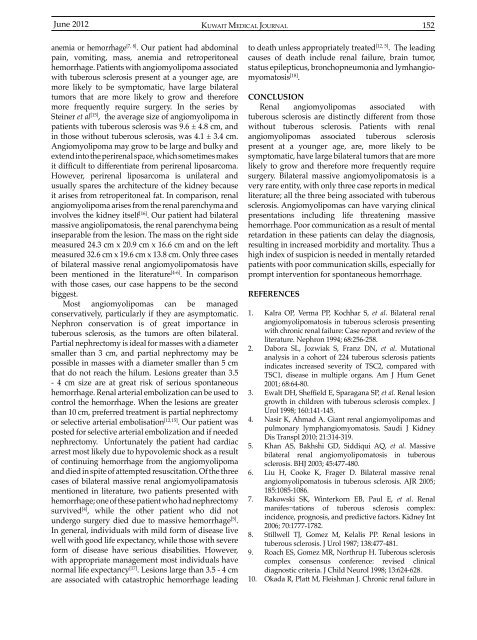Vol 44 # 2 June 2012 - Kma.org.kw
Vol 44 # 2 June 2012 - Kma.org.kw
Vol 44 # 2 June 2012 - Kma.org.kw
You also want an ePaper? Increase the reach of your titles
YUMPU automatically turns print PDFs into web optimized ePapers that Google loves.
<strong>June</strong> <strong>2012</strong><br />
KUWAIT MEDICAL JOURNAL 152<br />
anemia or hemorrhage [7, 8] . Our patient had abdominal<br />
pain, vomiting, mass, anemia and retroperitoneal<br />
hemorrhage. Patients with angiomyolipoma associated<br />
with tuberous sclerosis present at a younger age, are<br />
more likely to be symptomatic, have large bilateral<br />
tumors that are more likely to grow and therefore<br />
more frequently require surgery. In the series by<br />
Steiner et al [15] , the average size of angiomyolipoma in<br />
patients with tuberous sclerosis was 9.6 ± 4.8 cm, and<br />
in those without tuberous sclerosis, was 4.1 ± 3.4 cm.<br />
Angiomyolipoma may grow to be large and bulky and<br />
extend into the perirenal space, which sometimes makes<br />
it difficult to differentiate from perirenal liposarcoma.<br />
However, perirenal liposarcoma is unilateral and<br />
usually spares the architecture of the kidney because<br />
it arises from retroperitoneal fat. In comparison, renal<br />
angiomyolipoma arises from the renal parenchyma and<br />
involves the kidney itself [16] . Our patient had bilateral<br />
massive angiolipomatosis, the renal parenchyma being<br />
inseparable from the lesion. The mass on the right side<br />
measured 24.3 cm x 20.9 cm x 16.6 cm and on the left<br />
measured 32.6 cm x 19.6 cm x 13.8 cm. Only three cases<br />
of bilateral massive renal angiomyolipomatosis have<br />
been mentioned in the literature [4-6] . In comparison<br />
with those cases, our case happens to be the second<br />
biggest.<br />
Most angiomyolipomas can be managed<br />
conservatively, particularly if they are asymptomatic.<br />
Nephron conservation is of great importance in<br />
tuberous sclerosis, as the tumors are often bilateral.<br />
Partial nephrectomy is ideal for masses with a diameter<br />
smaller than 3 cm, and partial nephrectomy may be<br />
possible in masses with a diameter smaller than 5 cm<br />
that do not reach the hilum. Lesions greater than 3.5<br />
- 4 cm size are at great risk of serious spontaneous<br />
hemorrhage. Renal arterial embolization can be used to<br />
control the hemorrhage. When the lesions are greater<br />
than 10 cm, preferred treatment is partial nephrectomy<br />
or selective arterial embolisation [12,15] . Our patient was<br />
posted for selective arterial embolization and if needed<br />
nephrectomy. Unfortunately the patient had cardiac<br />
arrest most likely due to hypovolemic shock as a result<br />
of continuing hemorrhage from the angiomyolipoma<br />
and died in spite of attempted resuscitation. Of the three<br />
cases of bilateral massive renal angiomyolipamatosis<br />
mentioned in literature, two patients presented with<br />
hemorrhage; one of these patient who had nephrectomy<br />
survived [4] , while the other patient who did not<br />
undergo surgery died due to massive hemorrhage [5] .<br />
In general, individuals with mild form of disease live<br />
well with good life expectancy, while those with severe<br />
form of disease have serious disabilities. However,<br />
with appropriate management most individuals have<br />
normal life expectancy [17] . Lesions large than 3.5 - 4 cm<br />
are associated with catastrophic hemorrhage leading<br />
to death unless appropriately treated [12, 5] . The leading<br />
causes of death include renal failure, brain tumor,<br />
status epilepticus, bronchopneumonia and lymhangiomyomatosis<br />
[18] .<br />
CONCLUSION<br />
Renal angiomyolipomas associated with<br />
tuberous sclerosis are distinctly different from those<br />
without tuberous sclerosis. Patients with renal<br />
angiomyolipomas associated tuberous sclerosis<br />
present at a younger age, are, more likely to be<br />
symptomatic, have large bilateral tumors that are more<br />
likely to grow and therefore more frequently require<br />
surgery. Bilateral massive angiomyolipomatosis is a<br />
very rare entity, with only three case reports in medical<br />
literature; all the three being associated with tuberous<br />
sclerosis. Angiomyolipomas can have varying clinical<br />
presentations including life threatening massive<br />
hemorrhage. Poor communication as a result of mental<br />
retardation in these patients can delay the diagnosis,<br />
resulting in increased morbidity and mortality. Thus a<br />
high index of suspicion is needed in mentally retarded<br />
patients with poor communication skills, especially for<br />
prompt intervention for spontaneous hemorrhage.<br />
REFERENCES<br />
1. Kalra OP, Verma PP, Kochhar S, et al. Bilateral renal<br />
angiomyolipomatosis in tuberous sclerosis presenting<br />
with chronic renal failure: Case report and review of the<br />
literature. Nephron 1994; 68:256-258.<br />
2. Dabora SL, Jozwiak S, Franz DN, et al. Mutational<br />
analysis in a cohort of 224 tuberous sclerosis patients<br />
indicates increased severity of TSC2, compared with<br />
TSC1, disease in multiple <strong>org</strong>ans. Am J Hum Genet<br />
2001; 68:64-80.<br />
3. Ewalt DH, Sheffield E, Sparagana SP, et al. Renal lesion<br />
growth in children with tuberous sclerosis complex. J<br />
Urol 1998; 160:141-145.<br />
4. Nasir K, Ahmad A. Giant renal angiomyolipomas and<br />
pulmonary lymphangiomyomatosis. Saudi J Kidney<br />
Dis Transpl 2010; 21:314-319.<br />
5. Khan AS, Bakhshi GD, Siddiqui AQ, et al. Massive<br />
bilateral renal angiomyolipomatosis in tuberous<br />
sclerosis. BHJ 2003; 45:477-480.<br />
6. Liu H, Cooke K, Frager D. Bilateral massive renal<br />
angiomyolipomatosis in tuberous sclerosis. AJR 2005;<br />
185:1085-1086.<br />
7. Rakowski SK, Winterkorn EB, Paul E, et al. Renal<br />
manifes¬tations of tuberous sclerosis complex:<br />
incidence, prognosis, and predictive factors. Kidney Int<br />
2006; 70:1777-1782.<br />
8. Stillwell TJ, Gomez M, Kelalis PP. Renal lesions in<br />
tuberous sclerosis. J Urol 1987; 138:477-481.<br />
9. Roach ES, Gomez MR, Northrup H. Tuberous sclerosis<br />
complex consensus conference: revised clinical<br />
diagnostic criteria. J Child Neurol 1998; 13:624-628.<br />
10. Okada R, Platt M, Fleishman J. Chronic renal failure in
















